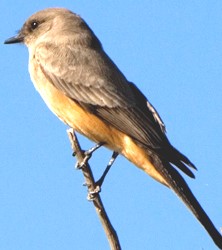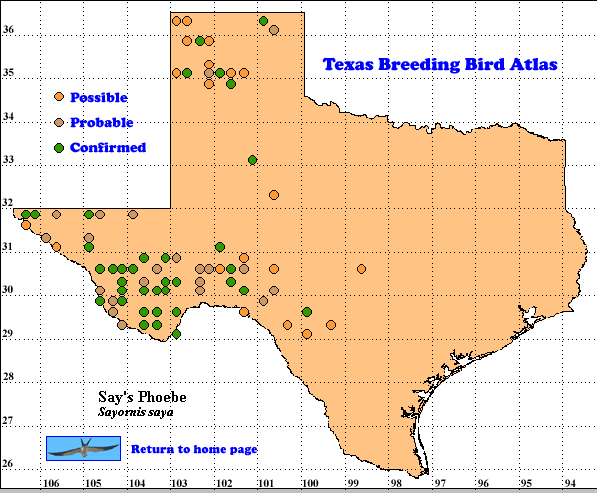Texas has all three species of phoebes present all year, a rare treat in the United States. Say’s Phoebe is a year-round resident in the Trans-Pecos and western Edwards Plateau regions with winter visitors scattered across southern Texas.
The drab appearance of this species makes it easy to overlook in its sparse habitats, but its “melancholy” call is distinctive. Its favorite foraging perches are 1-2 m, (3-7 ft) above ground and it flies from these to capture larger insects (Schukman and Wolf 1998).
DISTRIBUTION. During the 1987-1992 field work for the TBBA project, volunteers found most breeding records for Say’s Phoebe in the Trans-Pecos, western Edwards Plateau and northern High Plains regions of Texas. A few additional records come from the western Rolling Plains at the southern end of the Panhandle.
Outside Texas Say’s Phoebe breeds in central Alaska and northwest Canada. Another breeding range starts in British Columbia, Alberta and Saskatchewan and extends south through the interior west and western Great Plains to central Arizona and New Mexico. Say’s Phoebes are present year-round from northern California, northwest and southern Arizona, southern New Mexico to northerrn Baja California and south through the highlands of Mexico to the Isthmus of Tehuantepec. Migrants from northern breeding areas winter in these year-round areas and additional wintering areas along the California and northwest and east Mexican coasts (Schukman and Wolf 1998).
SEASONAL OCCURRENCE. Lockwood and Freeman (2004) characterize Say’s Phoebe as a year-round resident within the Trans-Pecos and western Edwards Plateau regions, but a summer resident in the Panhandle and an uncommon to rare migrant and winter visitor to the South Texas Brush Country.
The species breeds from late March to late August, eggs have been found from April 7 to July 27 with parents seen with nearly grown young as late as August 25 (Oberholser 1974). Ohlendorf (1976) reports a breeding season of May 10 to August 10 in the Trans-Pecos as determined from 45 nests.
BREEDING HABITAT. Say’s Phoebes breed from 300 to 1800 m (1000 to 6000 ft) elevation in open, arid country such as: ranches, sagebrush flats, foothills arroyos, and cliffs. Nests are often placed in or on buildings, (even inside a shed where a large diesel generator ran continuously) which they enter through any available opening. Nests are also found in caves, crevices in cliffs and arroyo banks, under bridges, in mine shafts and other sheltered places. In Trans-Pecos Texas nests were placed on man-made structures averaging 2.8 m (9 ft, n = 112 nests) above ground (Oberholser 1974, Ohlendorf 1976, Harrison 1979). The nest usually does not contain mud (unlike other phoebes) but is constructed of forbs, grasses, moss, hair and cocoons. The flat structure is lined with animal hair. The outside diameter is 14 cm (5.5 in), height 5.7 cm (2.1 in), inside diameter 6.5 cm (2.5 in), and cup depth 3 cm (1.2 in).
The female usually lays 3-4 dull white eggs, often unmarked (see Harrison [1979] for photo of markings). They are indistinguishable from those of other phoebes. The female incubates them for about 2 weeks and the young leave the nest 14-21 days after hatching. Parasitism by Brown-headed Cowbirds (Molothrus ater) is rare, breeding success is relatively high (30 of 45 nests produced at least one fledgling in the Trans-Pecos; Ohlendorf 1976). Two broods are frequently raised per year (Harrison 1979, Schukman and Wolf 1998).
STATUS. Lockwood and Freeman (2004) describe Say’s Phoebe as a common to uncommon resident in the Trans-Pecos and western Edwards Plateau regions and an uncommon to rare summer resident in the Panhandle.
North American Breeding Bird Survey (BBS) data show that observers on 40 km (25 mi) routes in the Trans-Pecos region detected 1-3 phoebes per route while in the northern and southwestern Panhandle and western Edwards Plateau, observers found <1 phoebe per route (Sauer et al. 2005).
The population trend data from 26 routes in Texas is +2.9% per year for the period 1966- 2004. The trend from 635 routes in the western United States and Canada is +1.6% for the same period (Sauer et al. 2005). These trends are encouraging for the future of Say’s Phoebe in Texas.
Text by Robert C. Tweit (2005)
Literature cited.
Harrison, H. H. 1979. A field guide to western birds’ nests. Houghton Mifflin, Boston, MA.
Lockwood, M. W. and B. Freeman. 2004. The TOS handbook of Texas birds. Texas A&M University Press, College Station.
Oberholser, H. C. 1974. The bird life of Texas. University of Texas Press, Austin.
Ohlendorf, H. M. 1976. Comparative breeding ecology of phoebes in Trans-Pecos Texas. Wilson Bull. 88: 255-271.
Sauer, J. R., J. E. Hines, and J. Fallon. 2005. The North American Breeding Bird Survey, results and analysis 1966-2004. Version 2005.1. USGS Patuxent Wildlife Research Center, Laurel MD (Web site, http://www.mbr-pwrc.usgs.gov/bbs).
Schukman, J. M. and B.O. Wolf. 1998. Say’s Phoebe (Sayornis saya). In The birds of North America, No. 374 (A. Poole and F. Gill, eds.). The Birds of North America, Inc., Philadelphia, PA.

